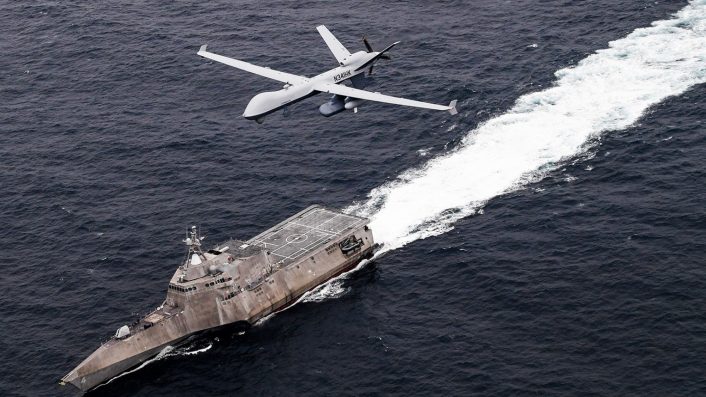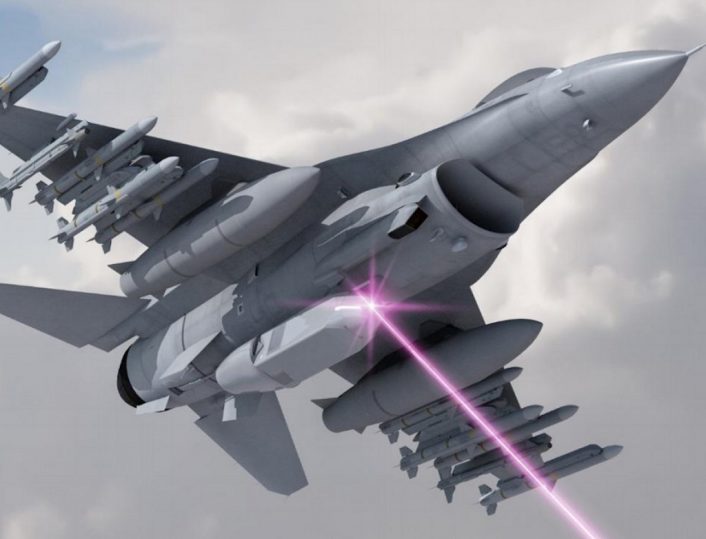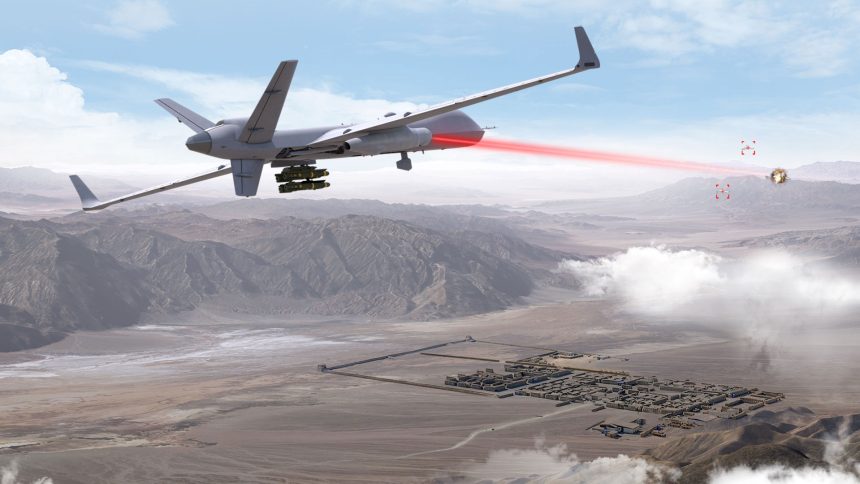The compact High-Energy Laser pod for MQ-9B is designed with Fleet Defense and Counter-UAS roles in mind.
General Atomics has unveiled the development of an airborne laser pod to equip the MQ-9B. The pod was put on display during the recent Navy League’s Sea Air Space 2025 conference, which was held on Apr. 6-9, 2025.
The system, part of the General Atomics Laser Weapon Systems portfolio, is based on a High Energy Laser (HEL), which the company further describes as a 25 kW-class distributed gain laser. The laser is said to be scalable to 300kW in both pulsed and continuous wave modes and capable of operating in all environments, while still adhering to tight size, weight, and power (SWaP) constraints.
The pod, installed under the MQ-9B’s wing, has a large aperture for the laser on the ball head, as well as a large ram air intake for cooling and an ultra-high power density battery system. “The system’s large optical aperture and efficient cooling offers significant reductions in size and weight to suit air, land and sea-based platforms,” said General Atomics.
The laser pod appears to be intended as a solution for fleet defense, as demonstrated by a rendering showing the MQ-9B engaging one-way attack (OWA) drones approaching a ship. In that setting, an airborne laser can provide highly effective defense against drone and missile threats with high accuracy, low cost and high reusability.
This topic is particularly relevant today, as demonstrated by recent events in Ukraine and in the Red Sea, where missiles worth thousands of dollars have to be used to destroy small drones or cruise missiles which cost much less than the weapons needed to counter them. The use of lasers would solve another big problem, the ammunition resupply, although there are some aspects which need to be considered.
In fact, a laser directed energy weapon can enjoy an unlimited magazine of ammo, however it needs to have a reliable source of energy. This might not be a problem for a laser installed on a warship, but it could certainly be for a land-based mobile system and even more for an airborne system.
The MQ-9B
The MQ-9B SkyGuardian is the next generation of remotely piloted aircraft systems (RPAS) developed by General Atomics Aeronautical Systems (GA-ASI), designed to deliver persistent intelligence, surveillance, and reconnaissance (ISR) around the globe with an endurance of over 40 hours.
Since the beginning, the aircraft has been designed to be able to safely integrate into civil airspace, without requiring segregated airspace. The MQ-9B is controlled via satellite and features automatic takeoff and landing.

The MQ-9B is based on the lessons learned from 8 million flight hours of the GA-ASI family of RPAs. Drawing on this experience, the SkyGuardian integrates enhanced payload capacity, including nine hardpoints with a max 4750 lb (2155 kg) external payload capacity, and an open architecture system, as well as the Lynx Multi-mode Radar and an advanced electro-optical/infrared (EO/IR) sensor.
“SkyGuardian is designed from the ground up to not only meet NATO standards (STANAG 4671) but also to comply with civil airspace requirements in the U.S. and around the world,” says GA-ASI. “Using GA-ASI’s first-of-its-kind Detect and Avoid System and Certifiable Ground Control Station, SkyGuardian seamlessly integrates with normal air traffic just like other commercial aircraft.”
The SkyGuardian served as the base for two derivatives: the SeaGuardian, focused on the maritime environment, and the Protector RG Mk 1, specifically outfitted for the needs of the Royal Air Force.
Airborne Laser Pod
The idea of an airborne laser pod to be used as defensive system is not new. In fact, this concept has also been explored in the past by the U.S. Air Force with the Self-protect High Energy Laser Demonstrator (SHiELD) program to protect aircraft from air-to-air and surface-to-air missiles. The new pod by General Atomics is, however, the result of a separate effort.

A rendering from 2018 showing the defensive laser pod used by an F-16V. (Image: Lockheed Martin)
The SHiELD program was launched by the Air Force Research Lab (AFRL), which was looking for a compact system able to provide self-protection against incoming threats and quick engagement of multiple targets over a wide field of regard and with a deep magazine. Similarly to the MQ-9B’s pod, the laser was expected be in the “tens of kilowatts” range.
As the U.S. military continued to face challenges during the development of laser weapons, SHiELD concluded in 2024 without a full prototype and test flights. The AFRL said, however, that it “has made significant advances in the readiness of airborne HEL [high-energy laser] technology, and we continue to mature airborne HEL weapons technology for the operational needs of today and tomorrow.” It is possible that some of the lessons learned with SHiELD found out their way into the MQ-9B’s pod.









